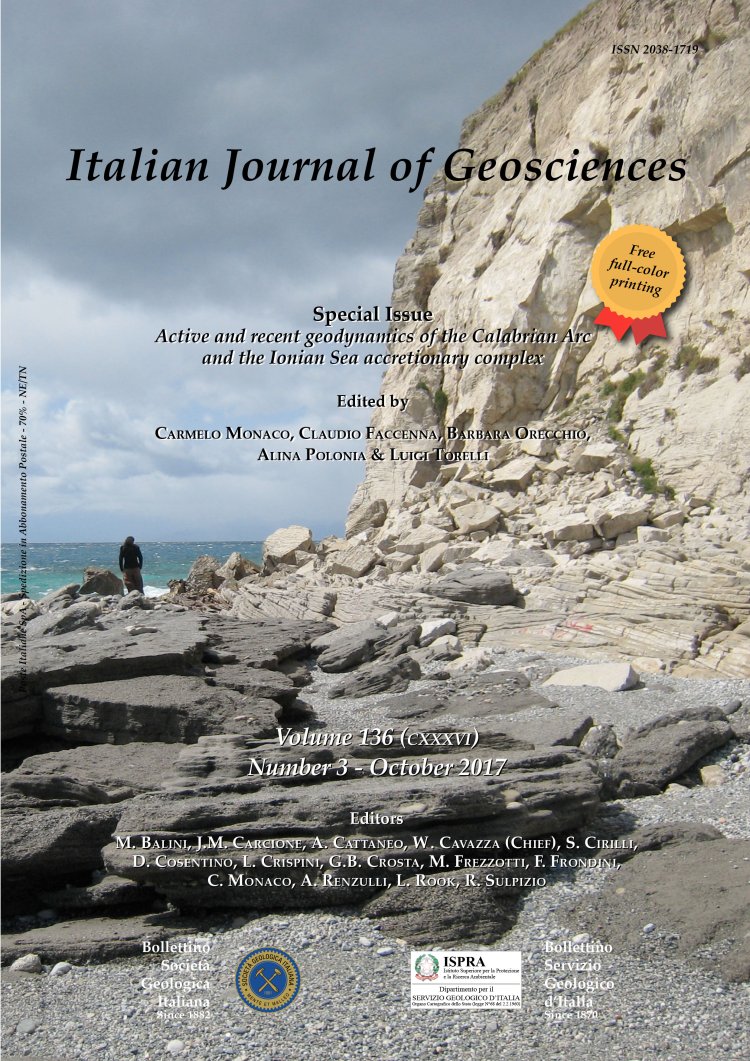
Understanding seismogenic processes in the Southern Calabrian Arc: a geodynamic perspective
Mara Monica Tiberti (1), Paola Vannoli (1), Umb erto Fracassi (1), Pierfrancesco Burrato (1), Vanja Kastelic (1) & Gianluca Valensise (1)
(1) Istituto Nazionale di Geofisica e Vulcanologia, Sezione di Sismologia e Tettonofisica, Via di Vigna Murata 605, 00143 Rome, Italy
Corresponding author e-mail: mara.tiberti@ingv.it.
Istituto Nazionale di Geofisica e Vulcanologia, Via di Vigna Murata 605, 00143 Rome, Italy. Phone: +39 06 51860443
Volume: 136 (2017) f.3
Pages: 365-388
Abstract
For any scientist working in seismotectonics, the Calabrian Arc represents the most challenging area of Italy. Lying on top of a subduction zone, it is characterised by a complex geological structure largely inherited from the early stages of the collision between the Africa and Eurasia plates. The current and extremely vigorous seismogenic processes, although generated by a mechanism driven by the subduction, are no longer a direct consequence of plate convergence.
About one fourth of the largest Italian earthquakes concentrates in a narrow strip of land (roughly 200x70 km) corresponding to the administrative region of Calabria. The present-day seismicity, both shallow and deep, provides little help in detecting the most insidious seismogenic structures, nor does the available record of GPS-detected strains.
In addition to its fierce seismicity, the Calabrian Arc also experiences uplift at rates that are the largest in Italy, thus suggesting that active tectonic processes are faster here than elsewhere in the country.
Calabrian earthquakes are strong yet inherently elusive, and even the largest of those that have occurred over the past two centuries do not appear to have caused unambiguous surface faulting. The identified active structures are not sufficient to explain in full the historical seismicity record, suggesting that some of the main seismogenic sources still lie unidentified, for instance in the offshore. As a result, the seismogenic processes of Calabria have been the object of a lively debate at least over the past three decades.
In this work we propose to use the current geodynamic framework of the Calabrian Arc as a guidance to resolve the ambiguities that concern the identification of the presumed known seismogenic sources, and to identify those as yet totally unknown. Our proposed scheme is consistent with the location of the largest earthquakes, the recent evolution of the regions affected by seismogenic faulting, and the predictions of current evolutionary models of the crust overlying a W-dipping subduction zone.
About one fourth of the largest Italian earthquakes concentrates in a narrow strip of land (roughly 200x70 km) corresponding to the administrative region of Calabria. The present-day seismicity, both shallow and deep, provides little help in detecting the most insidious seismogenic structures, nor does the available record of GPS-detected strains.
In addition to its fierce seismicity, the Calabrian Arc also experiences uplift at rates that are the largest in Italy, thus suggesting that active tectonic processes are faster here than elsewhere in the country.
Calabrian earthquakes are strong yet inherently elusive, and even the largest of those that have occurred over the past two centuries do not appear to have caused unambiguous surface faulting. The identified active structures are not sufficient to explain in full the historical seismicity record, suggesting that some of the main seismogenic sources still lie unidentified, for instance in the offshore. As a result, the seismogenic processes of Calabria have been the object of a lively debate at least over the past three decades.
In this work we propose to use the current geodynamic framework of the Calabrian Arc as a guidance to resolve the ambiguities that concern the identification of the presumed known seismogenic sources, and to identify those as yet totally unknown. Our proposed scheme is consistent with the location of the largest earthquakes, the recent evolution of the regions affected by seismogenic faulting, and the predictions of current evolutionary models of the crust overlying a W-dipping subduction zone.
Keywords
Get Full Text